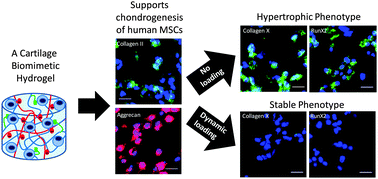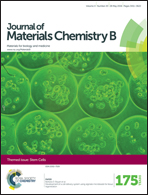Mechanical loading inhibits hypertrophy in chondrogenically differentiating hMSCs within a biomimetic hydrogel†
Abstract
Three dimensional hydrogels are a promising vehicle for delivery of adult human bone-marrow derived mesenchymal stem cells (hMSCs) for cartilage tissue engineering. One of the challenges with using this cell type is the default pathway is terminal differentiation, a hypertrophic phenotype and precursor to endochondral ossification. We hypothesized that a synthetic hydrogel consisting of extracellular matrix (ECM) analogs derived from cartilage when combined with dynamic loading provides physiochemical cues for achieving a stable chondrogenic phenotype. Hydrogels were formed from crosslinked poly(ethylene glycol) as the base chemistry and to which (meth)acrylate functionalized ECM analogs of RGD (cell adhesion peptide) and chondroitin sulfate (ChS, a negatively charged glycosaminoglycan) were introduced. Bone-marrow derived hMSCs from three donors were encapsulated in the hydrogels and cultured under free swelling conditions or under dynamic compressive loading with 2.5 ng ml−1 TGF-β3. hMSC differentiation was assessed by quantitative PCR and immunohistochemistry. Nine hydrogel formulations were initially screened containing 0, 0.1 or 1 mM RGD and 0, 1 or 2 wt% ChS. After 21 days, the 1% ChS and 0.1 mM RGD hydrogel had the highest collagen II gene expression, but this was accompanied by high collagen X gene expression. At the protein level, collagen II was detected in all formulations with ECM analogs, but minimally detectable in the hydrogel without ECM analogs. Collagen X protein was present in all formulations. The 0.1 mM RGD and 1% ChS formulation was selected and subjected to five loading regimes: no loading, 5% strain 0.3 Hz (1.5% s−1), 10% strain 0.3 Hz (3% s−1), 5% strain 1 Hz (5% s−1), and 10% strain 1 Hz (10% s−1). After 21 days, ∼70–90% of cells stained positive for collagen II protein regardless of the culture condition. On the contrary, only ∼20–30% of cells stained positive for collagen X protein under 3 and 5% s−1 loading conditions, which was accompanied by minimal staining for RunX2. The other culture conditions had more cells staining positive for collagen X (40–60%) and was accompanied by positive staining for RunX2. In summary, a cartilage-like biomimetic hydrogel supports chondrogenesis of hMSCs, but dynamic loading only under select strain rates is able to inhibit hypertrophy.

- This article is part of the themed collection: Stem Cells

 Please wait while we load your content...
Please wait while we load your content...